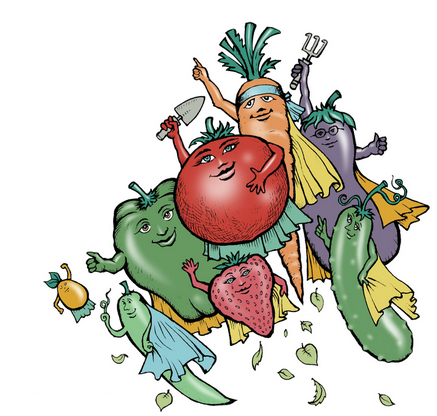By Teresa Gale
Yoga and food gardening are two of my favorite things. For me, both are equally effective antidotes to stress. Both my mat and my garden are sacred spots where I turn off and tune in. Everything else can wait.
Like yoga, food gardening makes me feel grounded. Yes, I’m literally digging in the dirt. But on a more spiritual level, the experiences of food gardening – planting a seed, picking a tomato, eating a snap pea straight off the vine – engage my senses and keep me present. Neither yoga nor food gardening gives me instant gratification. With each, progress is incremental and I observe without judgment.
We often describe yoga in terms of nature. We salute the sun and stand rooted like trees. We attune our bodies and minds to cycles of the natural world. As in nature, a summer yoga practice offers ample opportunity for growth and abundance.
Yoga asks that we be mindful both on and off the mat. While eating is a routine act, it is also a conscious choice. One way to eat mindfully is to choose fruits and vegetables that are in season and, if possible, grown locally.
July and August are the high points of food gardening season here in Chicago, with favorites like tomatoes, cucumbers and zucchini multiplying by the minute. Read on for tips on how to make the most of your garden bounty, whether you’ve grown it yourself or brought it home from the local farmers market.
Writing this Book
My family’s roots are in rural Indiana. When I was very young, we moved to the West Coast. I grew up in California’s central valley at the epicenter of modern “agri-business,” but personally disconnected from agriculture. From time to time, my grandma would write me letters about what she was growing in her garden back in Indiana. Corn, beans, kohlrabi. These letters were quaint and endearing, but inconsequential. In the summers we would visit my grandparents on the farm. We always ate fresh-picked veggies. I loved inspecting their freezers full of home-grown food. The basement stock of jams, pickles and other preserved goods was equally intriguing. It all seemed so foreign.
Years later I ended up here in Chicago. The summer my husband and I moved into our new home coincided with the birth of our daughter. We now had a small plot of land, and he suggested we start food gardening. In my new-mom stupor, I said something like, “You mean growing our own vegetables? That’s too much work.” But he managed to persuade me otherwise.
I remember feeling so proud of our first harvest. “We did this ourselves!” I marveled. And for the first time, I felt connected to a family history that had always eluded me. Food gardening became truly magical once I saw it through the eyes of my daughter. These special moments – tracing the curve of a pea tendril, hiding in the tomato “forest,” watching a butternut squash vine so high we couldn’t see the end – have convinced me never to stop.
Blanching and Freezing Tomatoes
If you can’t possibly consume all your tomatoes while they’re still fresh – don’t worry! Frozen tomatoes are great to have on hand for sauces, soups and stews. paste and beefsteak varieties take well to freezing, while cherry tomatoes don’t (enjoy these while they’re still fresh). Tomato skins don’t break down well when cooked, so it’s best to “blanch” your tomatoes to remove their skins from the flesh prior to freezing.
The blanching process is quick and easy. prepare your tomatoes by cutting out the stems. Using a slotted spoon, lower the fruit into a pan of boiling water, with only a few tomatoes in the pan at a time. Leave them for about a minute (you might see the skins start to crack or peel back from the top), then transfer them to a bowl of ice water to stop them from cooking. Once the tomatoes are cool, peel off the skins by hand. You can freeze them whole or cut them in half, remove the seeds and freeze the halves.
Since tomatoes are juicy, they have a tendency to stick together as they freeze. To keep the pieces from turning into one big chunk, arrange them in a single layer on a baking pan to freeze. Once they’re frozen solid, transfer them into a freezer bag, and you can pull them out one at a time as needed.
If you don’t want to spend time blanching your tomatoes, it’s OK to freeze them whole with the skins on. When you’re ready to use them, let them thaw out first and then peel off the skins with a knife. this method requires a bit more peeling than a blanched tomato, but works just fine.
Excerpt and illustrations from Fearless Food Gardening in Chicagoland, reprinted with permission from the Peterson Garden Project. The book is available for purchase at petersongarden.org.

























No Responses to “Fearless Food Gardening”